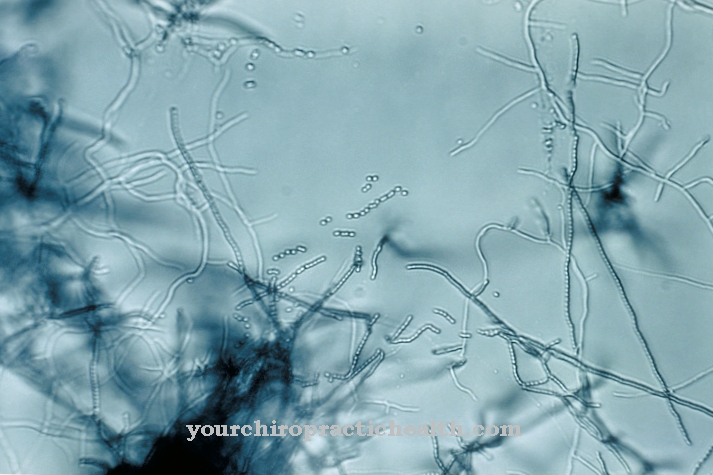The acronym ECHO in the name of Echo viruses stands for Enteric Cytopathic Human Orphan. It is a virus from the enterovirus family that causes gastrointestinal infections, skin rashes, and neurological and flu-like symptoms. In most cases, echoviruses enter the human circulation via the digestive tract. Further entry points are the respiratory tract and fecal-oral transmission. Echoviruses are characterized by a high level of environmental resistance.
What are echo viruses?
Echoviruses are non-enveloped, spherical RNA viruses that belong to the enterovirus genus. Like Coxsackie and Polioviruses, they are counted in the Picornaviridae family. Human echoviruses, the reservoir (host) of which is humans, are in the molecular classification (Humana Enteroviruses HEV A-D) under the species Human Enterovirus B (HEV-B) summarized.
A total of 27 serotypes are distinguished, with types 22 and 23 being assigned to the genus Parechovirus. This virus is one of the many viruses that preferentially affect the gastrointestinal tract. After the rhinoviruses that cause cold symptoms, the enteroviruses are the most common type of virus in humans.
The part of the name “orphan” (orphan) goes back to the fact that echoviruses were first discovered in the 1950s without a clear association with other infectious diseases. Echoviruses cannot be clearly assigned either pathogenetically or systematically.
Occurrence, Distribution & Properties
The name "Picornaviridae" goes back to the size of this virus genus, because the individual viruses are just 22 to 30 nm in size and are among the smallest of their kind. The other components of the name describe an enteric, cytopathic and human virus.
Echoviruses can be found worldwide, but mainly in countries with poor socio-economic infrastructures, with poor hygiene and contaminated wastewater playing a major role. In countries with temperate climates, infections by the echovirus mainly occur in summer and autumn. Frequently occurring serotypes such as type 30 can also be detected all year round.
Some types of viruses such as Echo 13 and Echo 18 can cause increased outbreaks of meningitis after a longer latency period. In most cases, the echovirus enters the human circulation through the lymphoid organs and epithelia of the pharynx and digestive tract. There it multiplies in order to subsequently spread to the surrounding tissue.
Other possibilities of infection with the echovirus exist via a smear infection through fecal-oral transmission and via the respiratory tract using droplet infection. Contaminated hands play a crucial role in this. The indirect transmission occurs via virus-contaminated objects, bath water or food. The viruses spread to all objects that come into contact with the hands and contaminated faeces and can survive there for a longer period of time.
Echoviruses have a special affinity for heart muscle tissue and therefore develop a cardiotropic effect (influencing the heart). The most common subtype in the detection of antibodies is the echovirus 30. After successful reproduction in the digestive tract, the echoviruses spread throughout the body and can cause serious diseases of the central nervous system. Infection of the lungs, spleen, liver and bone marrow is also possible.
Infected people excrete echoviruses in their stool for several weeks. A vaccine is not yet available, but the risk of infection can be reduced by regular hand washing and careful hygienic measures when preparing and consuming peeled fruit and cooked food.
Illnesses & ailments
For children and adults with healthy immune systems, echovirus infection is usually safe if treated in a timely manner. Often infected people do not feel any symptoms because a healthy immune system is usually able to fight off an infection with echoviruses. Anyone who has ever been infected with enteroviruses develops type-specific immunity. However, if symptoms do arise, the patients experience mild, neurological symptoms with fever and rash as well as summer flu-like side effects. Other mild accompanying symptoms are a sore throat and dry, irritating cough.
In his generalized disease, pneumonia, encephalitis, heart muscle inflammation, pericarditis and blood poisoning can occur, with Echo 11 being classified as particularly dangerous. Echo 7, 11 and 70 are often associated with conjunctivitis, while Echo 6 and 9 mainly cause pleural and muscle pain. Viral meningitis is the most common condition that can cause chills, nausea, stiff neck, headache and sensitivity to light. Symptoms usually go away without complications within two weeks.
Children and toddlers are often particularly irritable. Complications during pregnancy have not yet been identified with an echovirus infection. In infants, this infection is rarely fatal if it goes undetected or if treatment starts too late because it settles primarily in the heart or liver and often insufficient antibodies have been produced. Although children and young children are more at risk than adults, the disease process is less severe for them.
The average incubation period is 7 to 14 days, but a latency period of 2 to 35 days is also possible. The purely symptomatic treatment, which is aimed at the affected organ system, is carried out with antivirals that inhibit the reproduction and release process of the bacteria. Gamma globulins are used for severe disease sales. However, tests specifically aimed at echoviruses are not carried out because the course of the disease is usually not serious.
The diagnosis is made via a rectal swab, a throat swab, a stool sample or an examination of the spinal fluid. A differential diagnosis must be made to other enteroviruses that can cause similar clinical pictures.




























